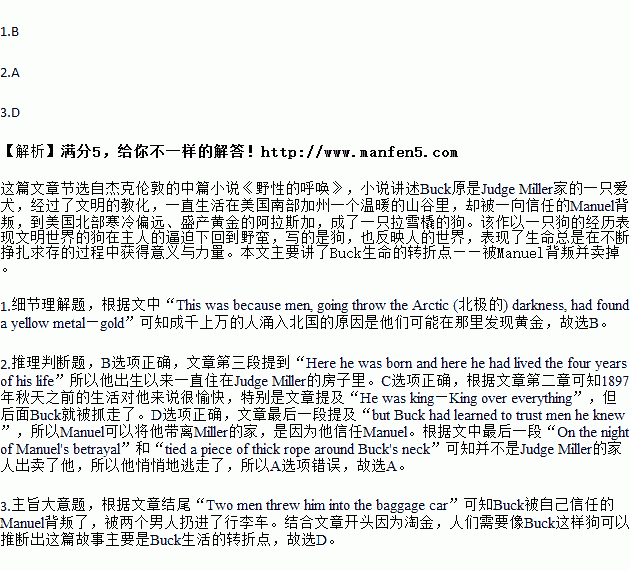题目内容
Characters:
Buck —a dog
Judge (法官) Miller—Buck's owner
Buck did not read the newspapers, or he would know that trouble was coming.
In fact, trouble was on its way for every strong dog with warm long hair. This was because men, going throw the Arctic (北极的) darkness, had found a yellow metal—gold. And because shipping and transportation companies were advertising the discovery, thousands of men were rushing into the Northland. These men wanted heavy dogs, with strong muscles for working and thick coats to protect them from the cold.
Buck lived at Judge Miller’s house in the sunny-kissed Santa Clara Valley. There were big stable (马厩), long grape fields, fruit gardens and a big swimming pool. Buck ruled over the whole kingdom. Here he was born and here he had lived the four years of his life. He protected the judge's sons and daughters on long midnight or early morning walks. On cold winter nights, he lay at the Judge's feet in front of the warm library fire. He was king—King over everything, crawled (爬行), walked, or flew at Judge Miller's place, including humans.
Buck was this kind of dog in the autumn of 1897 when the discovery of gold in the Klondike pulled men from all over the world into the frozen North. But Buck did not read the newspapers. He did not know that Manuel, one of the gardener's helpers, was not to be trusted. Manuel loved to gamble (赌博). He believed he could win but he was doomed (注定) to failure.
On the night of Manuel's betrayal (背叛), no one saw him and Buck go off through the fields. Buck imagined it to be a relaxing walk. They arrived at a little train. A man talked with Manuel and money passed between them. Manuel tied a piece of thick rope around Buck's neck. Buck accepted it quietly. To be sure, it was unwanted, but Buck had learned to trust men he knew. However, when the ends of the rope were placed in the stranger's hands, he barked. Then, the rope tightened (收紧) painfully, his tongue hanging out of his mouth. Then his strength disappeared, his eyes grew dim (浑浊), and he knew nothing when the train pulled up. Two men threw him into the baggage car.
(Adapted from The Call of the Wild by Jack London)
1.Why were thousands of men rushing into Northland?
A.Because they could live a better life there.
B.Because they might discover gold there.
C.Because they could find the dogs they needed there.
D.Because they wanted to enjoy the beautiful views there.
2.Which description about Buck is NOT TRUE according to the story?
A.The Judge's family betrayed him so he ran away quietly.
B.He had lived in Judge Miller's house since he was born.
C.Life before the autumn of 1897 was enjoyable for him.
D.Manuel could take him out of Miller's house because he trusted Manuel.
3.The story is mainly about ___________.
A.animal's trust in humans B.people's discovery of gold
C.Buck's early life at Judge Miller's D.the turning point of Buck's life


 B.
B. C.
C.